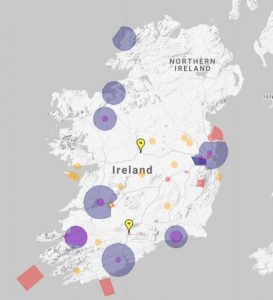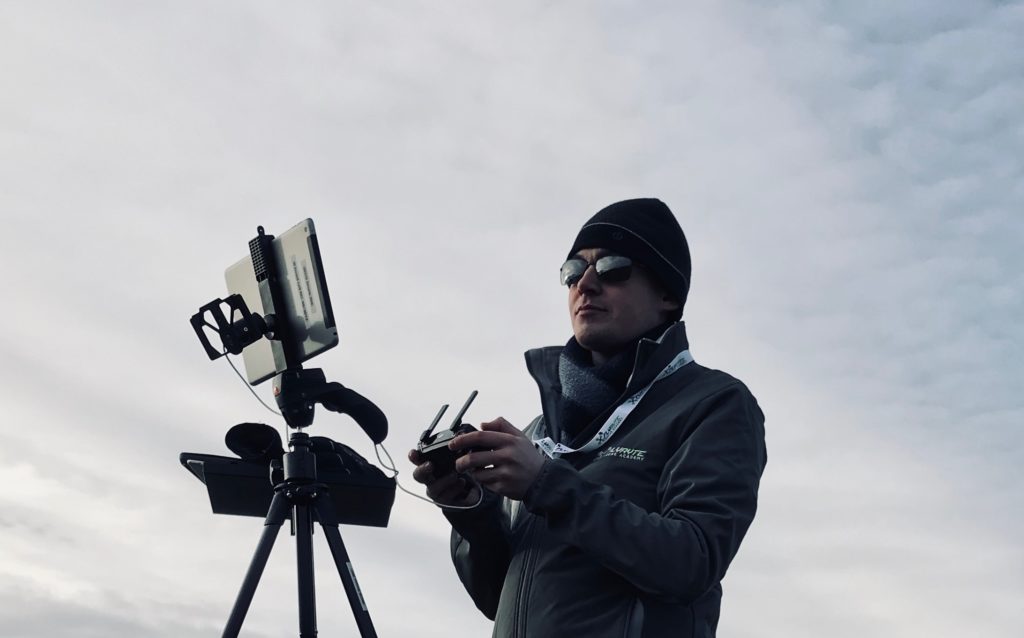Drone technology has become quite the buzzword of late in industry. Many companies and public bodies have sought to realise the productivity, cost saving and safety benefits of using drones to assist with their work. Colm Keena, an instructor with FlyRyte Drone Academy writes on what to consider when you looking at integrating drones into your organisation.
It is important to state from the outset that drones have huge potential to deliver efficiencies for a wide range of organisations. Initially when introduced to Ireland the main application of drone technology was in film and photography, but over the last number of years, we have seen drone technology being deployed in search and rescue, construction, agriculture, surveying, tourism and environmental protection to name but a few applications. Irrespective of what sector you are looking to utilise your drone in through this article I hope to outline some of the key things you should consider as part of bringing drone technology into your organisation.
Over the last number of years through my work at FlyRyte Drone Academy I have been involved in assisting public bodies and companies in Ireland and Europe with introducing drones into their organisations. In that time, I have seen some of the pitfalls associated with introducing drone technology. I have spoken at several conferences on this topic and the key message I try to convey at such events is that drones are not a one size fits all solution. Too often organisations think that by purchasing the hardware they will automatically gain commercial advantages. There are three areas which we at FlyRyte recommend focusing on before ever pressing take-off on your drone plans.
It is important that before investing in drone technology you outline what it is you want to gain from using drones in your organisation. This will assist with ensuring you purchase the right drone for what it is you want to achieve. Drones in and of themselves are not a silver bullet for operations but should be seen as a fantastic tool to complement and enhance existing processes within an organisation.
The second area which any organisation must consider when it comes to using drones is where the drones will be positioned in the organisational structure. If the use of drones is not designated to appointment holders then the natural movement of personnel within organisations can lead to a loss of skills, experience and momentum for drone operations within the company.

The final area we highlight to organisations is the need to ensure appropriate levels of training and upskilling to ensure that ultimately drone operations are conducted in a safe, responsible and legal manner. Drone licencing falls under the remit of the Irish Aviation Authority (IAA). Training requirements are laid down by the IAA through the relevant Drone legislation SI 563/2015. This will be discussed in greater detail in this article.
Taking the necessary time to accurately assess the three areas mentioned above is, in my experience, crucial to an organisation achieving long term benefits from the use of drone technology. This is in no small way due to the nature of the technology itself, take for example the current market leading drones such as the DJI Mavic or DJI Phantom. I liken them to the early days of the mobile phone, we are very much at the outset of drones as mainstream commercial technology. The rate of technological advancement over the last number of years has continued apace and provided an organisation has a clear grasp of their vision, organisational structure and training then they will be suitably placed to gain further advantages as the technology continues to develop.

When instructing on training courses, I often meet students who have little to no drone flying experience and even those who have yet to buy a drone themselves. There is a common misconception that the real challenge of drones is in the flying of them. The latest off the shelf drones are equipped with such levels of automation that the drones are, in most cases, capable of near full autonomous flight. The integration of GPS satellites, an internal magnetic compass, internal gyros and other sensors gives huge levels of safety to the user. The real complications in modern drones lies not with the flying of the drone but the understanding of what system you are using, and crucially the implications if that system has failed. This is something which we discuss in detail on our 2-day ground school course and there are any number of examples out there through YouTube and other sources which show you just what happens when people fail to consider the failure of such systems!
The rapid growth of drone technology has posed several challenges for legislators and public bodies throughout the world. By their nature drones now share the airspace used by commercial aircraft. This is not something which was really foreseen even ten years ago. Off the shelf drones costing as little as fifty euro have the capability to seriously impact on the safe operations of manned aviation. This was infamously demonstrated at Christmas of 2018 when multiple drone sightings shut London’s second busiest airport Gatwick over a two-day period. While we wait the official report on the incident, I would describe the event as a gamechanger for drone technology. This was the first time that we saw the deliberate targeting of commercial aviation by drones and the impact such targeting could have on operations.
I think it is important to highlight that this is where the importance of legislation, its enforcement and effective training come into play. Ireland has long been recognised as a world leader in commercial aviation, this is as applicable when it comes to drone legislation. Ireland was one of the first countries in Europe to legislate for the use of drones. Where other countries sought to ban their use, Ireland recognised the need to integrate both manned and unmanned aviation. We will now look in a bit more detail at what the current Irish drone legislation means for those thinking about using drones in their day to day operations.
Statutory Instrument 563/2015 outlines what a user can and can’t do with their drone. Some of the key points are listed in the picture above.
The statutory instrument sets out in broad strokes the overarching aims of the legislation.
This is then further enhanced by publications known as Aeronautical Notices. Aeronautical Notices are additional information or context to how the statutory instrument will be implemented. In Ireland there are three such notices which are applicable to drones. They deal with drone registration, training requirements and exemptions to allow drones fly in controlled airspace. So, what does this mean for you if you are considering buying a drone and using it in your organisation?

Firstly, you will have to register your drone with the IAA. This process is completed online, and you will receive a registration number specific to your drone. Secondly you will need to consider getting suitably trained. With the necessary training completed you will be able to apply to the IAA for a Pilot Competence Certificate (PCC) this qualification will allow you to apply to fly in controlled airspace. Controlled airspace is the airspace around airports which is designed to provide aircraft with suitable protection as the take-off and land at airports. You can see from the map inset that controlled airspace surrounds the three main airports in Ireland of Dublin, Cork and Shannon. In addition to the main airports there is also controlled airspace around the regional airports. and allow you to apply for specific exemptions from SI 563, thus allowing you to request bespoke limits for your operation.
![]()

At present the training is broken into two parts ground school and a practical flight exam. When it comes to flying a drone one of the key messages, I try to impress on students is the reality that the physical flying of the drone is in fact the easy part of the process!
The real learning when it comes to drones is being sure that you are operating in a safe, legal and efficient manner. To that end, I believe that the ground school training is key.
Over the last number of years FlyRyte has drawn on our staff’s collective years of civilian and military flight experience to develop a programme of training that is in keeping with and in many respects setting the industry standard for drone training.
Such a level of ground school training arms respective students and organisations with the ability to practice and develop their drone flying to the type of operation that they need. While the courses cover topics such as the legislation, airspace, meteorology, principles of flight and emergency procedures we also conduct some practical flight demos to highlight some of the things to consider whether you have been flying a drone for years or have never flown one before.


My focus on training, and effective ground school training ties back to the three key areas which I outlined above as the things you should consider before introducing drone technology into your organisation.
By answering and addressing these three areas you lay the broad stable base for your organisation to be able to reap the benefits of using drones to assist with your day to day operations. While I cannot say with any deal of certainty just where drone technology will progress to in the coming years, I am sure that drones are here to stay. We are at the infancy of this industry and this technology. The time to consider incorporating this technology is now. I hope that this piece proves of interest and assists you in planning a way forward for your organisation to harness the reward of incorporating drones into your organisation.
Colm Keena is an Instructor with FlyRyte Drone Academy. He holds BSC in Management and Aeronautical Studies and has been involved in training organisations to use drones both in Ireland and Europe.
His background in aviation stems from a career as a military pilot and flight instructor.
Drones: Where To Start
With so many units available in the market, many tailored for specific professional purposes, it can be hard to know where to start when purchasing your first drone.
Let’s have a look at some of the more popular sellers on the market and what they have to offer.


Mavic Pro
The DJI Mavic Pro compact, professional grade powerful drone. Its compact size hides a high degree of complexity that makes it one the industry’s most sophisticated flying cameras ever. 24 high-performance computing cores, an all-new transmission system with a 7lm range (depending on conditions and interferences), 5 vision sensors, and a 4K camera stabilised by a 3-axis mechanical gimble, are at your command with just a push of your thumb or a tap of your finger.
RRP: €1500 approx
Mavic 2 Zoom
Mavic 2 Zoom is one of the first consumer drones with zoom capability, providing a dynamic perspective for the evolving age of aerial imaging and storytelling.
With DJI Mavic 2 Zoom, you can get closer to the subject at a moment’s notice by combining two-times optical zoom (24-48mm) with two-times digital zoom to create a 98mm telephoto lens that captures lossless video in full HD resolution.
RRP: €1500+ approx
Mavic Air
The smallest professional grade drone currrently available commercially, the DJI Mavic Air flies for 21 minutes with a video transmission of 4 km. It’s has a 10 km max flight range without wind and has a max height above sea level of 5 km. The best thing about this unit is its size, with little difference to a smartphone when it’s folded up, making it highly portable.
RRP: €900 approx
Inspire 2
The Inspire 2 is the latest version of DJI’s professional cinematography grade drone offering. The image processing system , records video at up to 6K resolution at cinema grade quality and 5.2K resolution in Apple ProRes format. It goes from 0 to 80 kph in just 5 seconds and hits a maximum speed of 94 kph and has a max descent speed of 9 metres per second, a remarkable level of agility in an aircraft this size. A dual battery system prolongs the flight time to a maximum of 27 minutes while self-heating technology allows it to fly even in low temperatures.
RRP: €3400 for basic model approx. Up to €14000+ for premium model.
DJI Phantom 4 Advanced
The predecessor to this unit (Phantom 4 Pro) was used by the Irish Naval Service in the Mediterranean while on deployment with Operation Sophia. This entry level professional drone has 20 minutes flight time, a transmission range of over 5km and shoots in 4k resolution, Like many drones in its class it also boasts a front obstacle avoidance system.
RRP: €1700 approx

DJI Spark
The Spark is a mini drone that features all of DJI’s signature technologies, specially designed for leisure, family and event use. With intelligent flight control options, a mechanical gimbal, and a camera with incredible image quality, the Spark has a top speed of 50 KM per hour and a flight time of 16 minutes. It can also transmit video within a range of 16 KM.
RRP: €500 approx
Autel Robotics EVO
The EVO is a portable camera drone with foldable arms and a sleek, compact form factor. It’s the flagship drone from US manufacturer Autel Robotics. It features a 4k, front rear and downward camera, shooting in 4k and has a 30 minute flight time with a 7k range.
RRP: €1000 approx.
Parrot Anafi
A light, portable, practical 4K camera from French manufacturer Parrot, the Anafi features a flight time of up to 25 minutes with a range of up to 4km. It also has a speed of up to 55km per hour and comes with eight propellors, a 16GB SD Card and a carry case. A robust, easy to use entry level drone.
RRP: €700 approx
YUNEEC Typhoon-H
Typhoon H is one of the most advanced aerial photography and videography drones available in such a compact size. Typhoon H offers flight durations of up to 25 minutes while filming with the a 4K ultra HD camera. The controller features a 7-inch touchscreen that displays live footage of your flight in HD 720p resolution and enables a wide variety of autonomous flight modes. The craft is designed for photography and videography within a range of 1.6km.
RRP: €1100 approx.
Ryze Tello
The Ryze Tello is the basic, entry level drone offering from DJI. It’s compact, robust and easy to use and has a 13 minute flight time with a flight range of 100 metres. The video transmission is done at 720 megapixels, and is transmitted via two antenna for extra stability. The unit weights just 80 grammes and has been built with an auto takeoff and landing capability, making it ideal for younger users. RRP: € 110 approx













